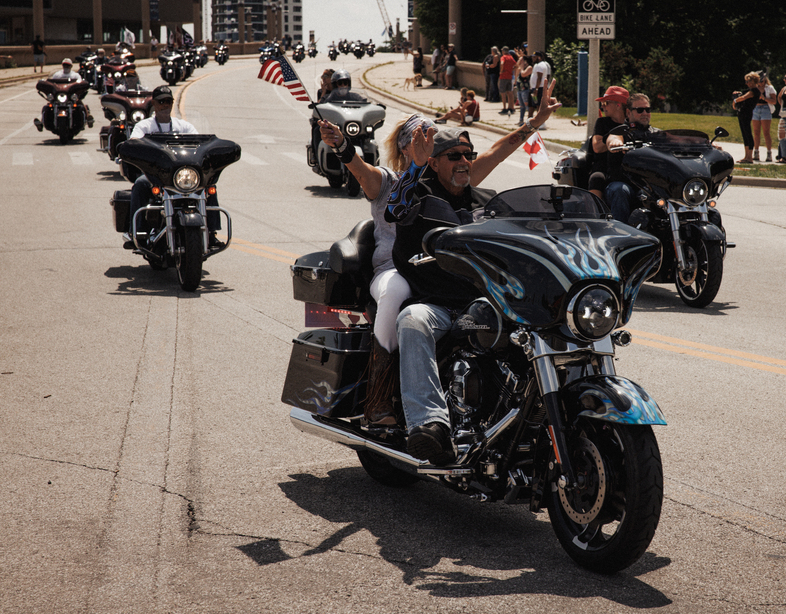There’s hard data. Sometimes we reach conclusions based on that. Then there are anecdotal observations, the impressions that impinge on our awareness by chance, as we go through life day to day. We often reach conclusions based on that (and are sometimes led astray because of it). When the two coincide… that’s when I feel confident.
Both the stats and my observations tell me that U.S. motorcyclists are not going extinct imminently, but damn, we are getting old. Enough that I think it’s fair to call us a (slowly) dying breed.
There are various estimates of the average age of U.S. motorcyclists, but the preponderance of the evidence suggests it’s somewhere around 50 years old. Think about that. Not many people can ride a motorcycle in their 80s, so that means there are enough gray-haired riders in their 50s through 70s to balance out all those who are eager teens, active 20-somethings, 30s in their prime, and 40s starting to consider the trajectory of their mid-life crises.
Another data point: Now, 50 years later, 1973 remains the year that the most new motorcycles were sold in the United States. Yes, the Baby Boomers were young, movies ranging from Easy Rider to On Any Sunday made different subcultures of motorcycling look cool and fun, and Japanese manufacturers had flooded into the U.S. market with models that were more affordable and reliable. The U.S. population today is about 57 percent larger than it was in 1973 but about half as many new motorcycles are sold per year.
Then there’s the nexus of where motorcyclists are figuratively a dying breed and literally dying individuals. That data also shows how motorcycling has gone from being a young man’s (still by far mostly men, though that’s changed somewhat) activity to being more old guys. According to the National Highway Transportation Safety Administration (NHTSA), in 1975, motorcyclists under 30 accounted for 80% of fatalities and riders 50 and older accounted for 3% of fatalities. In 2019, 28% of fatalities were riders under 30 and 37% were riders over 50.

While Harley-Davidson likes to show young people, women, and minorities in their photos (even though current management has backed off the aggressive efforts to attract women and minorities to the brand), the reality is that core customers are still white guys who are middle-aged and older. Harley-Davidson photo.
From motorcycle manufacturers to trade groups like the Motorcycle Industry Council, everyone has an interest in painting a positive picture, at least publicly, of the state of motorcycling in the United States, but the stats suggest that it’s a stagnant industry with a steadily aging customer base, and therefore a negative long-term trajectory.
And then, on top of the stats, there’s my personal anecdotal evidence. I’ll share just one small observation among many, but I think it’s telling.
Fifteen years ago, my wife started her second career, first as a college professor and then moving into administration. As a result, I’ve spent a lot of time on college campuses. We currently live in a tiny town dominated by a small college, and years ago we lived in an even smaller college town. One thing that struck me is when I’m riding around town on my motorcycles, with college students all around, almost none of them ever look at my bike. By contrast, when I was in college, motorcycles got a lot of admiring glances from my friends, even though most of them never rode.
For the most part, young people just don’t find motorcycles interesting, especially in the way my cohort did at that age. I know some people will counter with anecdotal evidence of their own, from “My neighbor’s kid is crazy about motorcycles” or “Look at all the thousands of motocross kids trying to qualify for Mini O’s or Loretta Lynn’s.” True. But those are the exceptions, not the rule. Look at the big numbers and the trend is clear.
The percentage of U.S. teenagers who have a driver’s license — never mind a motorcycle license — has been steadily falling and is now below 40%. There are many factors. Urbanization, the rise of transportation options such as Uber. (Some say it’s the cost of cars and motorcycles, but adjusted for inflation, they’re not really more expensive.) Why go to the trouble and expense of getting a driver’s license when you can just get an Uber and sit in the back seat keeping in constant touch with your friends on your phone? And learning to ride and getting a motorcycle endorsement on that license is another step. Not to mention that many young people today are more risk averse.
Add it all up and there’s no denying the U.S. motorcycle segment is not destined to be a growth industry. And it’s no surprise that when I ride through my small college town, if anyone looks up to see what I’m riding as I go by, it’s probably a guy with a gray beard, not a 19-year-old student with a backpack.

“Why go to the trouble and expense of getting a driver’s license when you can just get an Uber and sit in the back seat keeping in constant touch with your friends on your phone? And learning to ride and getting a motorcycle endorsement on that license is another step. Not to mention that many young people today are more risk averse.”
That all that needs to be said. No risk. No pain. No responsibility. Less expense.